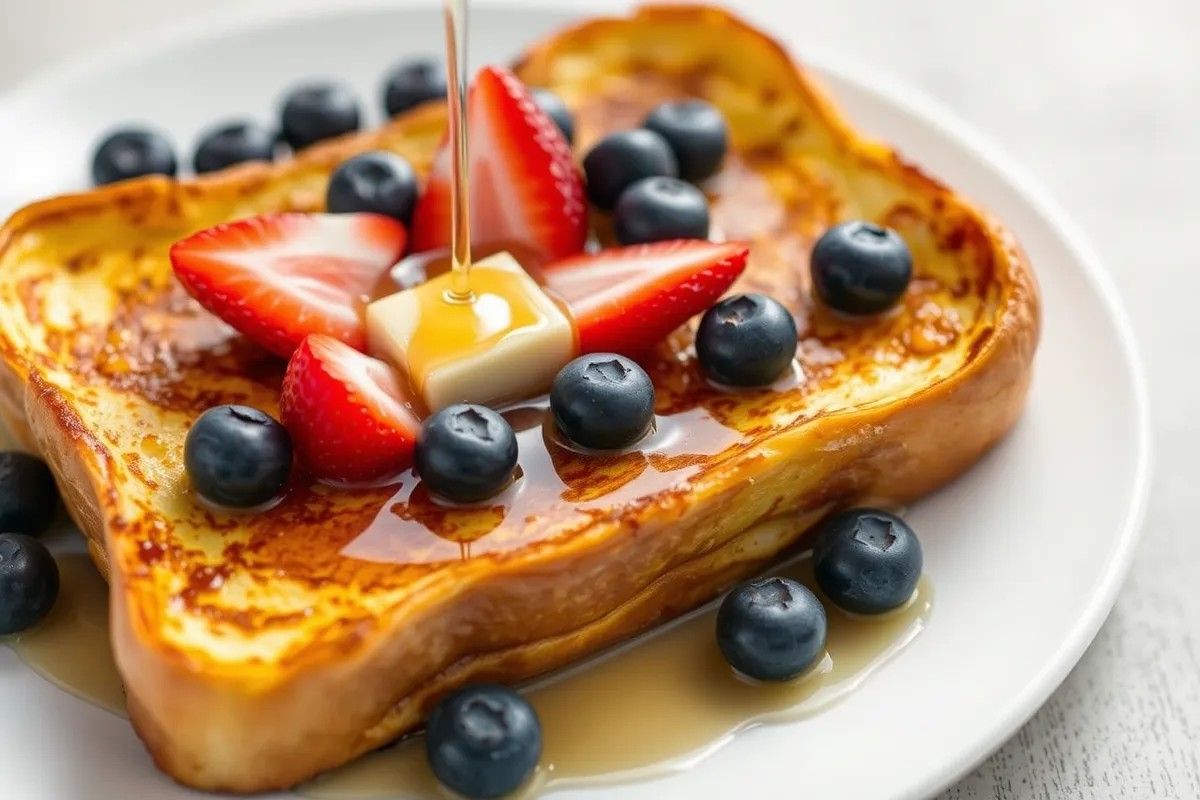Introduction
Few breakfast dishes evoke warmth and comfort quite like French toast. With its crispy edges, custardy interior, and endless variations, it’s a staple across many cultures. Whether you’re perfecting the classic recipe or exploring creative twists, mastering French toast recipes ensures every morning feels special. Let’s dive into the essentials, techniques, and flavor-packed variations for this beloved dish.
Comprehensive Outline
1. The Basics of French Toast
- What is French Toast?
- Historical Origins
- Essential Ingredients
- Bread types
- Milk and eggs
- Sweeteners and spices
- Kitchen Tools You’ll Need
2. How to Make Classic French Toast
- Step-by-Step Recipe
- Prepping the batter
- Choosing the best bread
- Cooking techniques for perfect texture
- Common Mistakes to Avoid
3. Popular Variations of French Toast
- Stuffed French Toast
- Cream cheese and berries
- Nutella and bananas
- Savory French Toast Options
- Herb and cheese
- Bacon and avocado
- Vegan and Dairy-Free Adaptations
4. Expert Tips and Tricks
- Achieving the Perfect Custard Consistency
- Balancing Sweetness and Spices
- The Ideal Soaking Time
- Making Ahead and Reheating
5. Creative Serving Ideas
- Toppings and Garnishes
- Fruits, syrups, and whipped cream
- Nuts and seeds
- Plating Inspiration
6. Nutritional Insights
- Caloric Breakdown of Classic French Toast
- Healthier French Toast Options
- Incorporating Protein and Fiber
7. French Toast Around the World
- “Pain Perdu” (France)
- Hong Kong-style French Toast
- “Torrijas” (Spain)
- American-Style French Toast
8. French Toast for Special Occasions
- Holiday-Inspired French Toast
- Pumpkin spice French toast
- Eggnog French toast
- Birthday and Celebration Variants
- Rainbow French toast
- Chocolate-dipped French toast
9. French Toast for Different Dietary Needs
- Gluten-Free French Toast
- Keto-Friendly Variations
- High-Protein French Toast
10. Advanced Techniques for French Toast Lovers
- Sous Vide French Toast
- Baked French Toast Casserole
- Caramelized French Toast with Crème Brûlée Topping
11. Frequently Asked Questions
- What is the trick to good French toast?
- What is the most common mistake in making French toast?
- What is the ratio of eggs to milk for French toast?
- How long should French toast soak?
12. Internal Links for Further Exploration
- Breakfast Smoothie Pairings
- Best Egg Recipes for Brunch
- Top 10 Homemade Syrups
13. Final Thoughts and Recommendations
- Why French Toast Deserves a Spot in Your Kitchen
- Exploring Global Takes on French Toast
The Basics of French Toast
What is French Toast?
French toast is a dish made by soaking bread in a mixture of eggs and milk, and then frying it to golden perfection. Known globally by different names—like “pain perdu” in France—it’s a simple yet versatile recipe. It’s not only a delicious treat but also a creative way to use leftover or stale bread.
Historical Origins
French toast dates back to ancient Rome, where it was known as “Pan Dulcis.” The Romans prepared it by soaking bread in milk and sometimes eggs before frying it. Over centuries, the dish spread across Europe, adapting to regional ingredients and preferences. In medieval Europe, sugar became a popular addition, turning French toast into a sweet delicacy for the wealthy. Today, it’s a globally recognized comfort food.
Essential Ingredients
To make the best French toast recipes, focus on quality:
- Bread: Choose brioche, challah, or sourdough for a rich texture. Stale bread works best as it absorbs the custard without falling apart.
- Milk and Eggs: Whole milk and fresh eggs are essential for creamy custard. Alternatives like almond or oat milk can be used for dietary needs.
- Sweeteners and Spices: Use vanilla, cinnamon, and a touch of sugar for depth of flavor. For a savory twist, skip the sugar and add herbs.
Kitchen Tools You’ll Need
- Non-stick skillet or griddle
- Mixing bowls and whisk
- Tongs or spatula
- Baking sheet for keeping French toast warm
How to Make Classic French Toast
Step-by-Step Recipe
Ingredients:
- 4 thick slices of bread
- 2 large eggs
- ½ cup whole milk
- 1 tsp vanilla extract
- ½ tsp ground cinnamon
- Butter for cooking
- Maple syrup (for serving)
Instructions:
- In a bowl, whisk eggs, milk, vanilla, and cinnamon until fully combined.
- Heat a skillet over medium heat and melt butter to coat the surface evenly.
- Dip each bread slice into the egg mixture, ensuring both sides are well-soaked but not dripping.
- Place the soaked bread on the skillet and cook until golden brown, about 2-3 minutes per side.
- Serve warm with syrup and toppings of your choice.
Common Mistakes to Avoid
- Over-soaking bread: Leads to soggy results. Adjust soaking time based on bread type.
- Skipping spices: Leaves the flavor bland. Cinnamon and vanilla are key for sweetness.
- Using high heat: Burn the outside while leaving the center undercooked. Moderate heat is crucial.
Popular Variations of French Toast
Stuffed French Toast
Cream Cheese and Berries:
- Spread cream cheese on one slice of bread, top with fresh berries, and seal with another slice before soaking.
Nutella and Bananas:
- Replace cream cheese with Nutella and layer with banana slices.
Savory French Toast Options
Herb and Cheese:
- Mix fresh herbs and grated cheese into the custard for a savory twist. Serve with a side salad.
Bacon and Avocado:
- Pair savory French toast with crispy bacon and avocado slices for a hearty meal.
Vegan and Dairy-Free Adaptations
- Replace eggs with a flaxseed mixture (1 tbsp flaxseed + 2.5 tbsp water).
- Use almond or oat milk instead of dairy milk. Add a pinch of turmeric for color.
Expert Tips and Tricks
Achieving the Perfect Custard Consistency
The custard should coat the back of a spoon but remain pourable. Adjust with milk if too thick.
Balancing Sweetness and Spices
Add a pinch of salt to enhance sweetness. Adjust cinnamon levels to taste.
The Ideal Soaking Time
Bread should soak for 20-30 seconds per side. Firmer bread like sourdough can soak longer without breaking.
Making Ahead and Reheating
- Prepare in batches and store in an airtight container. French toast recipes can be frozen and reheated in a toaster oven.
- To keep it warm before serving, place cooked slices on a baking sheet in a 200°F oven.
Creative Serving Ideas
Toppings and Garnishes
- Fruits: Fresh berries, banana slices, or caramelized apples
- Sweeteners: Maple syrup, honey, or powdered sugar
- Textures: Toasted nuts, granola, or shredded coconut
Plating Inspiration
- Arrange slices in a stack, drizzle with syrup, and add a dollop of whipped cream.
- Garnish with edible flowers for a gourmet touch.
Nutritional Insights
Caloric Breakdown of Classic French Toast
A serving of classic French toast contains approximately:
- Calories: 220-250 (without toppings)
- Protein: 7-10 grams
- Fat: 8-10 grams
- Carbohydrates: 30-35 grams
Healthier French Toast Options
- Use whole-grain bread for added fiber.
- Substitute sugar with natural sweeteners like honey or stevia.
- Incorporate egg whites to reduce fat content.
Incorporating Protein and Fiber
- Add protein powder to the custard mixture.
- Top with chia seeds or flaxseeds for extra fiber.
- Serve with Greek yogurt on the side for a protein boost.
French Toast Around the World
“Pain Perdu” (France)
A richer, custard-based version is often made with stale bread and served as a dessert.
Hong Kong-style French Toast
Deep-fried and typically filled with peanut butter or sweetened condensed milk. Served with a pat of butter and syrup.
“Torrijas” (Spain)
Soaked in milk and honey, then fried and dusted with cinnamon. Often enjoyed during Lent.
American-Style French Toast
Classic and versatile, often served with butter and maple syrup. Variations include stuffed or caramelized options.
French Toast for Special Occasions
Holiday-Inspired French Toast
Pumpkin Spice French Toast:
Add pumpkin puree and spice mix to the custard for a seasonal twist.
Eggnog French Toast:
Substitute milk with eggnog during the holiday season for festive flavor.
Birthday and Celebration Variants
Rainbow French Toast:
Use food coloring in the custard and stack layers for a colorful presentation.
Chocolate-Dipped French Toast:
Dip cooked French toast in melted chocolate and sprinkle with edible glitter or candies.
French Toast for Different Dietary Needs
Gluten-Free French Toast
- Use gluten-free bread. Ensure the custard mix is also gluten-free.
Keto-Friendly Variations
- Replace regular bread with keto bread. Use unsweetened almond milk and sugar-free sweeteners in the custard.
High-Protein French Toast
- Add protein powder to the custard and use whole-grain bread. Top with Greek yogurt and nuts.
Advanced Techniques for French Toast Lovers
Sous Vide French Toast
Sous vide cooking ensures even custard absorption and consistent texture. Simply vacuum-seal soaked bread and cook at 160°F for one hour before pan-frying.
Baked French toast recipes
Perfect for feeding a crowd, this method involves layering bread slices in a dish, pouring custard over them, and baking until golden.
Caramelized French Toast with Crème Brûlée Topping
Top your French toast with sugar and use a kitchen torch to caramelize it. This creates a crisp, sugary crust reminiscent of crème brûlée.
Frequently Asked Questions
What is the trick to good French toast?
Using slightly stale bread ensures it absorbs the custard without becoming too soggy.
What is the most common mistake in making French toast?
Oversoaking bread or cooking on too high heat are frequent pitfalls.
What is the ratio of eggs to milk for French toast?
A standard ratio is 1 egg per ¼ cup of milk.
How long should French toast soak?
Bread should soak for 20-30 seconds per side. Adjust based on thickness and freshness.

